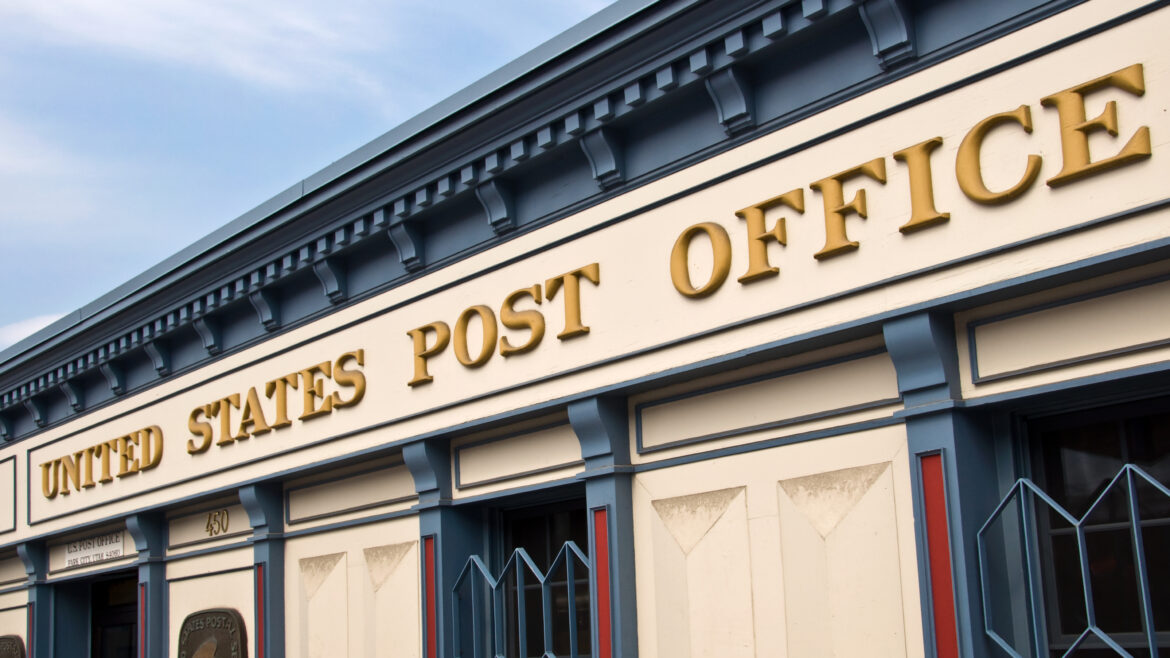The U.S. Postal Service’s check-cashing service that raised hackles in the banking community and among Republicans on Capitol Hill when it first was unveiled in September 2021 is quietly continuing—even though nobody is using it.
Starting that month, postal customers in four locations—Falls Church, Va.; Baltimore, Md.; the Bronx, N.Y.; and Washington D.C.—were able to cash payroll checks of up to $500 in exchange for gift cards.
Critics were outraged.
“The USPS was established to provide letter, parcel, and package delivery services across the country,” Brad Thaler, then-vice president of legislative affairs at the National Association of Federally-Insured Credit Unions, wrote in an October 2021 letter to the House Financial Services and Senate Banking committees. “An expanded foray into financial services would both go beyond the USPS’s purpose and powers and add responsibilities in which the USPS has no expertise and does not currently have the infrastructure and capacity to manage.”
Months later, House Republicans also expressed their disapproval.
“As of its launch, the program violated a statutory restriction on offering or developing new products outside the scope of USPS’s traditional postal services,” Republican leaders on the House Financial Services and House Oversight and Reform committees wrote, in a letter to Postmaster Louis DeJoy.
Despite their opposition, the pilot program continued, even though nobody—literally nobody—is using the program.
“Between September 13, 2021 and March 2022, a total of seven Gift Cards were purchased under the Pilot Program, generating a total fee revenue of $41.65,” the Postal Regulatory Commission said, in a report last month. “No sales have occurred since FY 2022 Quarter Two.”
You read that correctly. No sales.
When it was first established, the pilot program never used the word “banking,” since the USPS is prohibited from offering banking services. Congress would need to enact legislation for the service to actually provide banking services.
That was not always the case. Postal banking has a long history in the United States. In 1910, Congress created the Postal Savings System, which operated from 1911 to 1966. Even then, bankers opposed the idea.
Under the Postal Savings System, people could make savings deposits that were fully guaranteed by the federal government. The accounts earned 2% interest. By 1934, postal banks had $1.2 billion in assets, or about 10% of the entire commercial banking system, according to a 2014 white paper about postal banking written by the USPS Inspector General.
By 1946, 68% of the nation’s communities had postal savings depositories and banks, the IG said. Because depositors could receive higher interest rates for their deposits at commercial banks, and because the banks were readily accessible, USPS banks became less attractive.
In 1966, President Johnson sought to streamline the federal government, and as part of that plan, the postal banking system was abolished.
The idea, however, never died. In January 2014, the USPS IG issued its white paper that attempted to make the case that postal banking could reach underserved areas of the country, while also generating much-needed revenue for the USPS. “Postal organizations have an unmatched ability to reach consumers from diverse backgrounds,” the IG said.
The report also stated that, “Financial services have been the single best new opportunity for [the USPS] to earn additional revenue. For the Postal Service, this might ultimately translate into $8.9 billion per year.”
The IG said that the postal service could start out by pushing such services as money orders and international money transfers, adding that small market tests in key geographic areas could help show that there is a need for the services. “A quick victory or two could help garner stakeholder support for additional postal financial services,” the IG said.
The IG’s recommendations went nowhere, although Democratic members of Congress continued to try to enact postal banking legislation.
For instance, in 2020, Sens. Bernie Sanders, D-Vt. and Kirsten Gillibrand, D-N.Y. introduced legislation authorizing postal banking. “It is absolutely unacceptable that communities all over America lack traditional banking services,” Sanders said, as he introduced the legislation.
He said that predatory payday lenders were taking advantage of people who could not gain credit elsewhere. “The time has come to put predatory lenders out of business and provide affordable banking options to all Americans through the United States Postal Service,” Sanders said.
When the legislation was introduced, the Credit Union National Association vehemently expressed its opposition to the bill. “Congress doesn’t need to ask the postal service to [do] something it was not intended to do,” then-CUNA Chief Advocacy Officer Ryan Donovan said. “Congress should encourage all consumers—and certainly the most vulnerable—to seek out service from credit unions.”
CUNA continued to press Congress to allow all credit unions to expand their fields of membership to include underserved areas. “While everyone cannot join the same credit union, there is a credit union for everyone to join,” then-CUNA President/CEO Jim Nussle wrote, in a letter to members of Congress.
That legislation was not enacted.
The next year, Nussle continued voicing the trade group’s opposition to postal banking. “Credit unions are currently required to refuse banking services to many underbanked individuals and underserved communities who are not in their field of membership,” he said.
“Credit unions adamantly support and are diligently working towards the goal of expanding banking access, but we have grave reservations about proposals to leverage the United States Postal Service to provide banking services well beyond the Postal Service’s core competencies,” he added.
In 2021, USPS introduced the pilot check cashing service, which was met with controversy. In 2022, Gillibrand, Sanders, and Rep. Alexandria Ocasio-Cortez, D-N.Y. pushed to include an expansion of that pilot program in must-pass appropriations legislation. They failed, as Congress ultimately did not include that proposal in the appropriations measure.
During the current Congress, Rep. Rashida Tlaib, D-Mich., introduced legislation, H.R. 6775, that would establish public banks that would be controlled by state and tribal governments. The state and tribal governments could designate a non-profit organization to operate their banks. The bill also would authorize the postmaster general to partner with banks for retail accounts and payment services.
When she introduced the legislation, Tlaib voiced the same concerns that postal banking advocates have voiced for decades. “Wall Street-run banks are failing to serve many of my residents who are struggling to make ends meet,” she said. “It’s long past time to open doors for people who have been systematically shut out.”
So far, no companion bill has been introduced in the Senate. House Republicans have long-opposed postal banking and even tried to end the current pilot program. That opposition most certainly means that no postal banking legislation or expansion of the pilot program will be enacted while Republicans control the House.
At the same time, the postal pilot program has lurched along, despite the reluctance of the Postal Regulatory Commission. For instance, the commission has reminded the postal service that it, and not the USPS, controls what services may be offered.
The commission also has required the USPS to provide quarterly reports and to notify the commission about any plans to expand the program. “Despite the lack of sales, the Pilot Program remains operational with no plans for termination,” the commission said last month. “Thus, questions remain as to the nature of the program.”
In May 2023, members of “Save the Post Office,” including the America Civil Liberties Union, the NAACP and the American Postal Workers Union, released a report renewing their call for Congress to allow postal banking. They also said the limited pilot was doomed to fail from the start.
“The program is too limited in scope, only allowing individuals to cash payroll checks under $500,” the groups said. The postal service charges customers $5.95 to cash a $500 check to use for a gift card. That service charge is much too high, they claim, adding that the fee is the result of the USPS using a third-party intermediary for the service. The postal service also did not adequately market the pilot, except to place signs in the windows of the four specific locations.
Members of “Save the Post Office” had other objections to the setup of the pilot program. If the pilot was intended to test whether the Postal Service could serve unbanked people, the USPS chose the wrong sites, since several do not match the characteristics of unbanked communities. The specific locations chosen did not adequately represent the different types of communities that are served by the USPS. For instance, there was no rural location included in the pilot.
In addition, they pointed out that the pilot originally was supposed to cover full markets in 50 locations across the U.S., and they noted that when the Postal Regulatory Commission expressed reservations about the program, it was rolled back.
The groups suggested that the postal service could install low-fee ATMs in post offices. They continued to call for full-fledged postal banking, saying that the USPS could offer free checking and savings accounts in partnership with the Treasury Department.
Postal banking is the key to the postal service’s future, they contend. “These new sources of revenue and foot traffic would help secure the USPS’s financial future and ensure the provision of fair and equitable services for all of us,” they concluded.
Based on the politics of the situation, that is not likely to happen anytime soon.























































